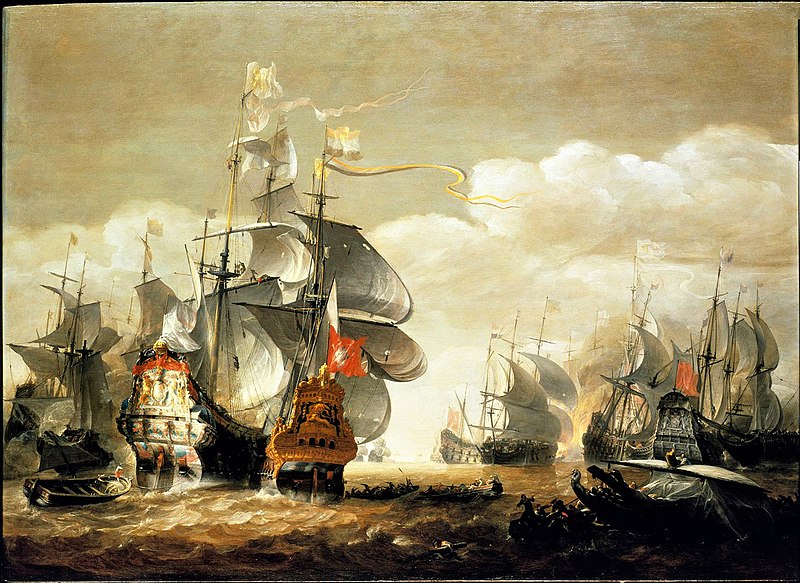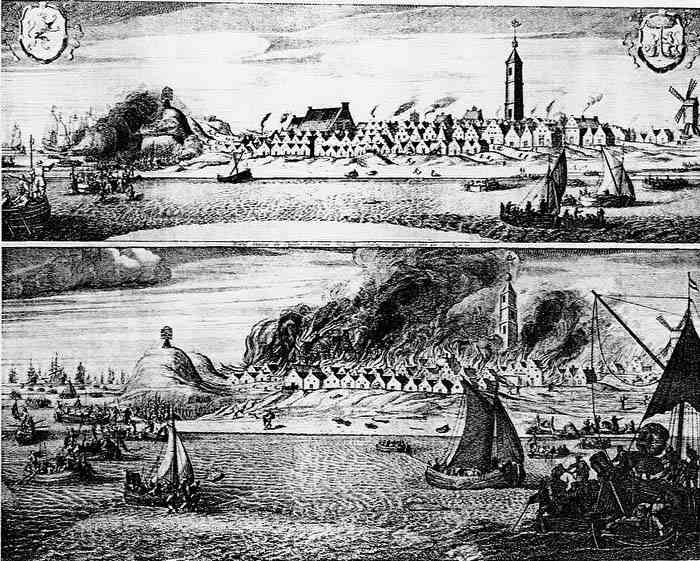 |
| The Battle of Lowestoft |
Fighting on the High Seas
Rupert fell
ill with complications to the head wound he had received in fighting during the
Thirty Years’ War. He did not recover to take part in active duty until late
1664 when he accompanied James on an inspection of the fleet. The inexperienced
James was overcome with the might of the English fleet and acquiesced when
Parliament pressed Charles to declare war on the Dutch and voting £2.5 million[i] to prosecute the 2nd Anglo-Dutch War[ii].
The most
important causus belli was trade; the
English were treading on the tails of the Dutch in America, Africa and the East Indies. Rupert was Vice-Admiral of the fleet and Admiral of the
Second Squadron under James’ leadership. James strategy was to blockade the
enemy ports until the Dutch fleets were forced to make a dash for the open
seas, to defend their trade routes.
The Battle of Lowestoft on 7th June 1665 was a victory for the
English sinking 20 Dutch warships and with four enemy admirals dead. But due to
an untimely intervention by Henry Brouncker[iii] the Dutch fleet escaped. Rupert
later reported to parliament;
‘I shall only say, in short,
if the Duke’s orders, as they ought, had been strictly observed, the victory
which was then obtained had been much greater, nay, in all probability the
whole fleet of the enemy had been destroyed.’[iv]
 |
| Sir Robert Holmes (R) with Sir Frescheville Holles |
During the
battle Rupert’s Rear Admiral, Robert Sansum died; to replace him Rupert nominated
his friend Robert Holmes. James preferred his own man John Harman[v].
‘The Duke went aboard the
Royal James to see Prince Rupert, who kept to his chamber of a sore
leg......but his Royal Highness thought more fit to give that flag to Capt.
Harman.’[vi]
Rupert’s man
Holmes then resigned his commission; he was however well able to support
himself with the civil and military appointments already gifted to him[vii].
Henrietta
Maria was horrified by the English losses during the fighting and persuaded
Charles that it was not suitable for the heir to the throne to put himself in
harm’s way. Accordingly James was confined to shore. Charles offered a joint
command to Rupert and the Earl of Sandwich, one of Rupert’s old adversaries.
Rupert felt that a divided command was worse than useless and declined.
Sandwich was put in overall control but was soon found guilty of taking bounty
from Dutch merchantmen and sent off to Spain as the English ambassador.
The Four Days Battle
 |
| the Four Days' Battle |
In early
1666 command of the navy was divided between George Monck[viii] and Rupert. The country
now faced the prospect of fighting not only the Dutch but also France; Louis
XIV had decided to oppose his cousin’s expansionist policies. The Netherlands
and France were joined by Denmark
in the war against the English.
Monck and
Rupert set about tightening discipline and demanded adequate and appropriate
ammunition for the fleet, now down to 66 ships[ix]. James ordered that the
fleet be divided between the two commanders. So when the French, under the Duke of Beaufort, left Toulon, Rupert sailed to
intercept him and Monck was left on his own to attack the Dutch.
The Four Day’s Battle begun twenty miles off Ostend. On 1st June Monck and his men were caught between two lines
of fire; the following day, reduced to 40 ships Monck attempted to sail back to
the English coast. He was joined by Rupert and his fleet on the afternoon of 3rd
June and the two admirals agreed to attack the following day. Pepys records
that Monck[x];
‘By and by spied the
Prince’s fleet coming......the Prince came up with the Generall’s[xi]
fleet, and the Dutch came together again and bore towards their own coast.’[xii]
The End of a Tumultuous Year
 |
| Holmes' Bonfire |
A further battle took place on 24th July
off Orford Ness, victory going to the English by a
narrow margin. On 9th August Robert Holmes, back with the navy, raided the islands
of Vlieland and Terschelling, off the Zuider Zee. He claimed to have burnt 150 merchantmen at anchor on the
islands, costing the Dutch £1 million[xiii].
In early
September Monck was diverted back to London to help deal with the consequences
of the Great Fire in London.
Rupert
prepared a detailed report on the campaigning season, blaming poor intelligence
about the intentions of the French fleet, the intentions of the Dutch and
finally the whereabouts of Monck when Rupert’s fleet was ordered to join them
to give battle. Rupert referred to ‘intolerable
neglect’ in provisioning and maintenance of the ships. He also recommended
that Harwich’s defences should be upgraded along
with those of Sheerness. The Duke of York’s decision to ignore
this advice was to cost the country dear.
%2C_Duchess_of_Cleveland_by_Sir_Peter_Lely.jpg/487px-Barbara_Palmer_(n%C3%A9e_Villiers)%2C_Duchess_of_Cleveland_by_Sir_Peter_Lely.jpg) |
| Barbara, Lady Castlemaine |
Pepys and
the Navy Board retaliated to Rupert’s complaints by asserting that Rupert
brought the fleet home in bad condition at the end of the fighting season. At a
meeting on 7th October Rupert informed a meeting that;
‘Whatever the gentleman
[Pepys] said, he had brought home his fleet in as good a condition as any fleet
was ever brought home.’[xiv]
Pepys and
the Navy Board were at cross purposes with Rupert. The navy was suffering from
underfunding; Pepys had asked for £100,000[xv] to keep the fleet afloat,
he was given £5,000[xvi] by Charles who was far
happier to lavish money on his mistresses, especially the voracious Lady Castlemaine who held the king in thrall.
Difficult Decisions
 |
| Trepanning |
During the
winter Rupert underwent two trepanning operations on his head to alleviate the problems caused by
his head wound. The second was to alleviate many of the problems caused by the
botched first operation. Rupert was having problems sleeping and the constant pain
in his head was worsening. Rupert believed that he would die, but Pepys wrote;
‘Since we told him that we
believe he would overcome his disease, he is as merry and swears and laughs and
curses, and do all the things of a man in health, as ever he did in his life.’[xvii]
Pepys
believed that Rupert’s illness was a result of the clap[xviii] having gone to
Rupert’s head.
News of
Rupert’s death were rumoured on the Royal Exchange on 16th February, but
Pepys was able to rectify the stories. Rupert used his convalescence to create
refined versions of the surgeon’s tools used in his operation.
The Earl of
Clarendon and his cronies were now responsible for the fatal decision to lay off
sailors and lay up the larger warships; made because they believed the war
almost won When he heard of the decision and was off his sickbed Rupert
protested to Charles.
Difficult Times
 |
| Battle of the Medway |
Early in
June 1667 de Ruyter’s men captured Sheerness. The majority of the Dutch fleet
remained off Sheerness but a force under Willem van Ghent attacked the Chatham navy yards in the Battle of the Medway. Van Ghent fired six warships and sailed off with
James’ flagship, the Royal Charles and the Unity; a PR disaster for both Charles and the Navy Board. Pepys
wrote;
‘Our hearts do now ake; for
the news is true, that the Dutch have broken the Chain[xix]
and burned our ships, and particularly the Royal
Charles; other perticulars I know not, but most sad to be sure.’[xx]
 |
| Upnor Castle |
Rupert was called
upon to assist James and Monck as they summonsed troops to Upnor Castle[xxi]. Rupert deployed a battery of
artillery at Woolwich, where he knew the enemy would have
to pass. Lord Arlington[xxii] wrote;
‘On Thursday they came on
again with 6 men of war and 5 fire ships.....but were so warmly received by
Upper (sic) Castle and battery on the shore that they were forced to retire,
with great damage beside the burning of their 5 fire ships.’[xxiii]
The Dutch
were at point blank range when Rupert, in his element, gave the first order to
fire. The Dutch retired to the mouth of the Thames and maintained control of
the Channel for the next few weeks.
In December
1667 Pepys proposed that any officer wishing to be made a lieutenant should
have served in the navy for three years, have a certificate from his captain
and passed an exam in navigation and seamanship at the Navy Office. Rupert
opposed this radical change, but the flag officers and Charles approved.
Bibliography
Prince
Rupert of the Rhine – Maurice Ashley, Purnell Book Services Ltd 1976
Samuel
Pepys, the Man in the Making – Arthur Bryant, Collins Clear Type Press 1948
The Later
Stuarts – George Clark, Oxford University Press 1985
Charles II –
Christopher Falkus, Weidenfeld & Nicholson 1972
The Shorter
Pepys – Robert Latham (ed), Penguin Books 1987
Prince
Rupert of the Rhine – Patrick Morrah, Constable & Company 1976
Man of War –
Richard Ollard, Phoenix Press 2001
Prince
Rupert – Charles Spencer, Phoenix Paperback 2008
Samuel Pepys
– Claire Tomalin, Alfred A Knopf 2002
[i]
In 2014
the relative: historic opportunity cost
of that project is £340,100,000.00 economic cost of that
project is £77,830,000,000.00 www.measuringworth.com
[ii]
The 1st
Anglo-Dutch War occurring during the Commonwealth, ending in August 1653
after the death of Admiral Tromp at the Battle of Scheveningen
[iii]
One of James’ courtiers
[iv]
Prince Rupert - Spencer
[v]
Later Admiral
[vi]
Man of War - Ollard
[vii]
Deputy Governor of the Isle of Wight, Governor of Sandown Fort and Captain of
his own Independent Company of Foot
[viii]
Now Duke of Albemarle
[ix]
The previous year’s plague had killed off many sailors
[x]
Pepys’ patron; Pepys had a low opinion of Rupert
[xi]
De Ruyter
[xii]
The Shorter Pepys - Latham
[xiii]
In 2014
the relative: historic standard of living
value of that income or wealth is £150,700,000.00 economic status value of that income or wealth is £4,208,000,000.00 economic power value of that income or wealth is £28,600,000,000.00 www.measuringworth.com
[xiv]
Rupert of the Rhine - Ashley
[xv]
In 2014
the relative: historic opportunity cost
of that project is £14,110,000.00 economic cost of that
project is £2,860,000,000.00 www.measuringworth.com
[xvi]
In 2014
the relative: historic opportunity cost
of that project is £705,700.00 economic cost of that
project is £143,000,000.00 www.measuringworth.com
[xvii]
Prince Rupert - Spencer
[xix]
Across the channel of the Medway
[xx]
The Shorter Pepys - Latham
[xxi]
An Elizabethan fort outside the Chatham dockyards
[xxii]
An ally of Barbara Castlemaine’s against Clarendon; Arlington was one of those
charged with management of the war
[xxiii]
Prince Rupert - Spencer
heh, I never knew Lowestoft and Orford had such excitement. The changes to the regulations for a lieutenant set the basis for the later Royal Navy of Nelson.
ReplyDelete